Throughout Ones to Watch, we’ve done an artist interview with all our exhibitors! Read on to find out about Charlotte Cullen’s work…
Your full name, and university course/year.
Charlotte Cullen, Graduated 2019 from practice led PhD at University of Huddersfield
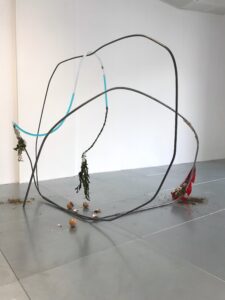
Can you describe your work to us in 3 words?
Physical, embodied, scrappy
What medium do you prefer to use?
I work predominantly in sculpture and installation; material and site lead my making and thinking. I also use text and sound, at times to think through ideas or at others in response to the materials I am working with. I have been working with metal over the last few years, as a material it is both malleable and rigid, the process is often quick and irreversible and shows the scars of its making.
What is the inspiration behind your work?
Long term illness, the fragile body, the personal and collective fight to keep going during politically cruel and uncaring times intersect with issues of identity and intergenerational trauma. Site is enacted as geological space for excavation, symbiotic (un)learning, resistance and healing. Intergenerational trauma, sickness and the body are manifest as material, physical encounters.
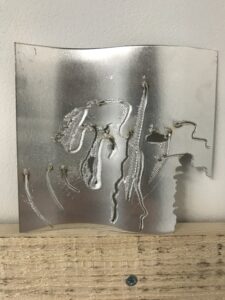
What is your most important artist tool? Is there something you can’t live without in your studio?
My studio is often shifting and developing as I am, the most important consistent presence I couldn’t live without is community. The support, critique, love and comradeship I’ve been fortunate to experience at my studio serf helps me to continue, reflect and develop. Ongoing conversations, even now in lockdown, are nourishing and indispensable.
During this uncertain time what will you do to occupy yourself?
I’m appreciating this time to pause, reflect and refocus. This sudden moment of stillness has put into sharper focus how busy I have been over the last year. I feel fortunate to have been supported and active since graduating but there are constant demands on your time and less opportunity to reflect and develop. I want to be careful and purposeful about engaging with the current shift to online content, thinking about new ways of being that don’t emulate the burn out cycle.
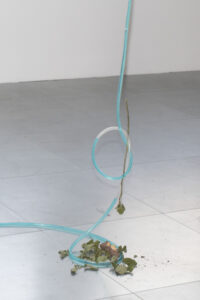
Which artists are you most influenced by?
So many and it’s constantly growing! At the moment Anne Hardy, Jesse Darling, Marie Lund, Olga Balema, Anna Reading, Yngvild Saeter, Jakob Choma, Yein Lee, Michael Dean, Dineo Seshee Bopape and many more. Pre-lockdown I saw Shelagh Cluett’s work exhibited at Leeds Art Gallery and Gillain Lowndes at York Art Gallery which were both incredible and have given me lots to think about while trying to work on a smaller scale and without facilities from home. I always return to Sarah Lucas, Barbara Hepworth and Eva Hesse as well.
How do you seek out opportunities?
Constantly, slowly and with some difficulty. Usually through listing sites like Axis web, Curatorspace and Artquest. Other times its through word of mouth, recommendations or reaching out to curators or spaces I respect. My focus this year was to apply for funding, to slow my process down and work more purposefully, but so much has changed so quickly at the moment and many funding opportunities have shifted focus so I will be following these developments.
Which current art world trend are you following?
I’m not sure it would count as a ‘trend’ but my research considered how diminishing resources are causing uncertainty for artists and impacting material modes of making, prompting material and formal enquiry informed by the precarious conditions of its production. This, I believe, has given rise to a making-do form of material practice where the embodied material nature of class, desire and disadvantage are politically and physically embedded within practice. Understanding this I trust my material explorations to lead me to better understand my position and I am most excited by artists expanding on immediate material enquiries positioned in a wider contemporary context of instability.
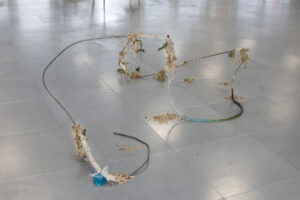
Plans for the future?
It’s difficult to make plans for the future during this tumultuous time and many of the plans that I did have in place are floating untethered at the moment. As I mentioned before I want to find support to reflect on and develop my practice more purposefully and with support to push avenues of my practice. I am interested in learning more about the production of metal and its pathways through our lives. I hope to better understand different qualities for various applications and its movements across borders so that I can engage more purposefully with this material and its life cycle. I’ve been teaching at York St John University this past year, which has been incredibly rewarding as well as introducing me to some brilliant sculpture equipment, so I am eager to return to the workshops to continue making. I have a solo exhibition, currently postponed (I would be installing as I write!) at Patriot Hall in Edinburgh. It will be my first solo exhibition outside of Leeds where I am based and the space is beautiful. It is sad to not be there now but I am using this time to reflect on this work, pushing it at the edges and understanding it better. Hopefully I will have something stronger and more robust to exhibit when the time comes.
Tell us about an exhibition that has stayed with you
Anne Hardy Falling and Walking ((phhhhhhhhhhh phossshhhhh crrhhhhzzz mn huaooogh) at Leeds Art Gallery 2018 has stayed with me for a few years now. The exhibition was experiential, physical, emotive and immersive in a way which is hard to pin down but which continues to inform how I think about my own processes and installation. For me a work is not finished until it is installed in space, where it can grow into the fabric of its environment. It’s about that moment between yourself and the materials when they speak, I aim to find a form that articulates that to an audience.
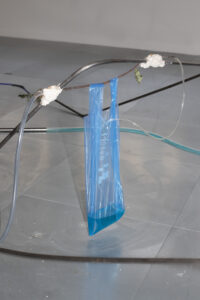
Any books/ films/tv series that you’d recommend for anyone interested in art?
Barbara Hepworth Figures in a Landscape (1953) is a beautifully shot film with a haunting score by Priaulx Rainier. Cecil Day Lewis narrates from Jacquetta Hawkes A Land (1951). It’s available on BFI player and is worth it just to see Hepworth making in her St Ives studio. I’ve been returning to A Land recently and also picked up a copy of Undermining by Lucy R. Lippard just before lockdown. My Mother Laughs by Chantal Akerman is a painfully honest and open account of her relationship with her mother which has stayed with me recently and I will always recommend Landscape for a Good Woman: A Tale of Two Lives (1986) by Carolyn Steedman which still feels deeply urgent now. For my recent solo show at serf in Leeds I held a film screening of Coherence which is available to watch online and is brilliant if you are comfortable with feeling further destabilised at the moment. I am also hoping to watch some Chantal Akerman movies while in lockdown, individual viewing costs are £10 for No Home Movie (2013) which was developed at the same time as the book mentioned above and I’ve been wanting to watch it for some time. Mostly though I’ve been re-watching Buffy, which I also highly recommend.
What are your favourite Instagram accounts?
Oh I’m not sure! I mostly follow individual artists accounts rather than reposting accounts. I love to see what @studemood is sharing and @anne__hardy has been sharing interesting works during this lockdown period. I’m excited to see what @shelllike will be doing after taking time to digest and develop something meaningful.
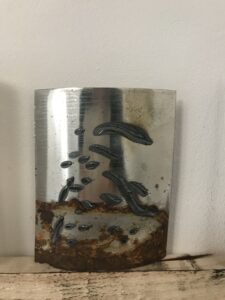
What is your dream project?
That’s such a big question! There’s quite a few without considering the projects that take you by surprise. Support to work site responsively on a large-scale project would be incredible, having the time to work from archival research, develop fieldwork responses and work with specialists and fabricators to produce work at an ambitious scale leading to a large immersive installation or outdoor sculpture garden would be a dream.
What is your most successful piece of work and why?
The series I have been working on for the last year Retreat of the Warrior was an important moment of trusting my materials, learning through mistakes and building work which gave body to an immediate, emotional struggle. It has been a significant development in my practice, I trust in the work as a place for conversation and understanding. It’s rewarding when this process becomes a form that I can begin to articulate to an audience.
Find out more about Charlotte’s work here.
Read another artist interview on our blog here, or look up all the Ones to Watch artists here!
Back To Blog Next (Ones to Watch: Bethany Chamberlain) Prev (Volunteers at Sunny Bank Mills Archive)Tags
General Arts & Culture
